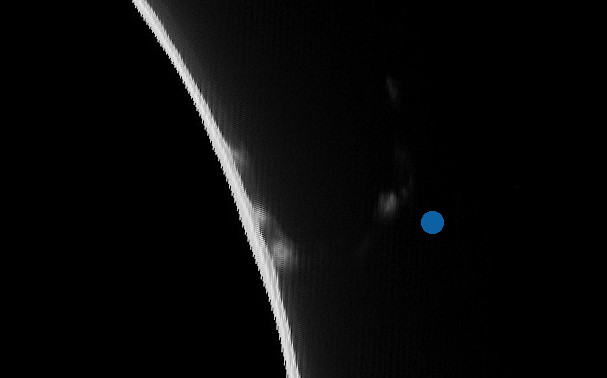Solar Flare
NOTE: To see the video version of this, see the April 29th entry below. This is a more expanded version.
On the morning of April 16, 2020, I decided to take a quick glance at
the sun to see if anything was happening. Glad I did. Most of the
time, I set the solar scope on a tripod to see if anything is
interesting enough to open the observatory and mount the solar scope
on the LX200GPS to track the sun and allow better imaging (than
trying to image from the tripod). This morning, there appeared to be
a large prominence at the edge of the sun, so I thought I would try
to image it. It was definitely different from what I usually see, so
it had already piqued my interest. What unfolded over the next hour
was a solar flare, the first one that I can say with assurance that
I've seen. Especially when I was presenting in the national parks,
the primary difference I would use to distinguish between a
prominence and a flare it that a flare would last minutes, a
prominence could last for days, or longer. I imaged from about 9:45
until a little after 11:00 AM (of course) and images were taken
approximately 1 minute apart. What follows is a few of those images,
with time stamps in the caption to show how quickly this all
happened. Comments under the picture.
 |
9:53 Pay close attention to the lower part (closest to sun) of the eruption, but follow the whole thing.
|
The flare started before I started imaging. Of course, I didn't know about it until I first looked. This is the first good image I could get.
 |
10:05 Notice how the "spout" has become a series of "balls" of plasma.
|
About 12 minutes later and the flare has started to form balls of plasma and "throw" them away from the surface of the sun. Using images around this time frame, I was able to determine an approximate speed for the ejection of material.
 |
| 10:14 The blue ball is the size of the earth. This allows a scale comparison. |
About 10 minutes later and the largest ball has moved further from the sun. Using the earth as a yard stick (of about 8000 miles), the ball has moved about 4 earth diameters along the curved path of the flare, That would be about 32,000 miles in 9 minutes, 20 seconds according to the time stamps on the images. That puts the speed of ejection around 200,000 MPH. I'm gonna have to say that's the fastest thing I've ever seen.
 |
10:20 Ball has "exploded".
|
Six minutes later, the earth sized ball has "exploded" or dissipated, leaving behind at least 2 remnants.
 |
10:33 All gone! Well, mostly.
|
Another 13 minutes and the flare is no more. However, what's left of the sun, looking like waves on the ocean, continue "sloshing" around for another 20 minutes.
No comments:
Post a Comment